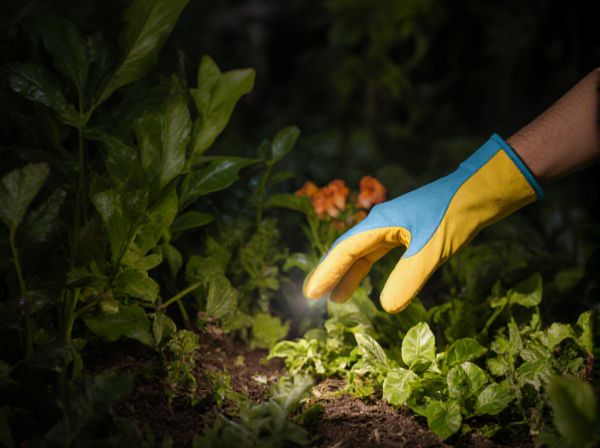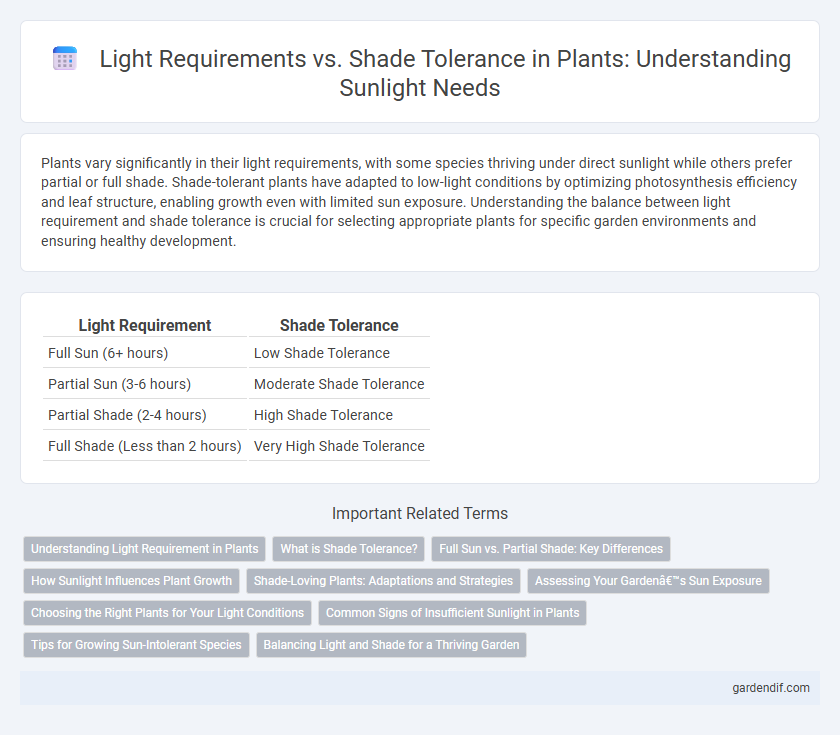
Light Requirement vs Shade Tolerance Illustration
Plants vary significantly in their light requirements, with some species thriving under direct sunlight while others prefer partial or full shade. Shade-tolerant plants have adapted to low-light conditions by optimizing photosynthesis efficiency and leaf structure, enabling growth even with limited sun exposure. Understanding the balance between light requirement and shade tolerance is crucial for selecting appropriate plants for specific garden environments and ensuring healthy development.
Table of Comparison
| Light Requirement | Shade Tolerance |
|---|---|
| Full Sun (6+ hours) | Low Shade Tolerance |
| Partial Sun (3-6 hours) | Moderate Shade Tolerance |
| Partial Shade (2-4 hours) | High Shade Tolerance |
| Full Shade (Less than 2 hours) | Very High Shade Tolerance |
Understanding Light Requirement in Plants
Light requirement in plants refers to the specific amount and intensity of sunlight necessary for optimal photosynthesis and growth. Most plants are categorized as full sun, partial sun, or shade tolerant, each adapting to varying light intensities that influence their chlorophyll production and overall health. Understanding these requirements is essential for gardeners to ensure plant vigor, maximize flowering, and prevent issues like etiolation or leaf scorch.
What is Shade Tolerance?
Shade tolerance refers to a plant's ability to grow and thrive in low-light conditions, often beneath the canopy of taller vegetation. Plants with high shade tolerance efficiently utilize diffused or indirect sunlight, adapting their leaf structure and chlorophyll concentration to maximize photosynthesis in shaded environments. Understanding shade tolerance is crucial for selecting appropriate species for shaded gardens, forest understories, or indoor spaces with limited natural light.
Full Sun vs. Partial Shade: Key Differences
Full sun plants require at least six hours of direct sunlight daily to thrive, supporting vigorous growth and abundant flowering. Partial shade plants perform best with three to six hours of sunlight, benefiting from afternoon shade to prevent leaf scorch and reduce water stress. Understanding these light requirements ensures optimal plant health and garden design by matching species to suitable sun exposure conditions.
How Sunlight Influences Plant Growth
Sunlight provides the energy necessary for photosynthesis, directly affecting plant growth and development by enabling carbohydrate production. Plants with high light requirements typically thrive in open environments where they receive ample direct sunlight, maximizing photosynthetic efficiency and growth rates. Shade-tolerant plants have adapted to lower light conditions by optimizing chlorophyll concentration and leaf structure to capture diffuse light, allowing them to survive and grow under canopy cover or shaded habitats.
Shade-Loving Plants: Adaptations and Strategies
Shade-loving plants exhibit specialized adaptations such as larger, thinner leaves with higher chlorophyll content to maximize light absorption under low-light conditions. They often utilize efficient photosynthetic pathways and optimize leaf orientation to capture diffuse sunlight while minimizing energy expenditure. These strategies enable survival and growth in understory environments where light availability is significantly limited compared to full sun exposure.
Assessing Your Garden’s Sun Exposure
Assessing your garden's sun exposure involves measuring the duration and intensity of sunlight throughout the day to determine the light requirement for each plant. Sun-loving species need at least six hours of direct sunlight, while shade-tolerant plants can thrive with less than three hours of filtered or indirect light. Understanding these sunlight patterns helps optimize plant placement, ensuring healthy growth and maximizing garden productivity.
Choosing the Right Plants for Your Light Conditions
Light requirement and shade tolerance are critical factors in selecting plants suited for specific outdoor environments, as plants with high light requirements thrive in full sun, while shade-tolerant species adapt well to low-light conditions. Understanding the photosynthetic needs and growth patterns of various plants ensures optimal placement, enhancing their health and development. Accurate matching of plants to available sunlight reduces stress, promotes vibrant foliage, and maximizes garden productivity.
Common Signs of Insufficient Sunlight in Plants
Plants exhibiting pale, elongated leaves and weak stems often signal insufficient sunlight, reflecting poor photosynthesis and energy production. Leaf drop, slowed growth, and smaller, sparse foliage are additional indicators that a plant is struggling with low light conditions. Understanding these common signs allows gardeners to adjust light exposure to meet specific species' light requirements or shade tolerance levels effectively.
Tips for Growing Sun-Intolerant Species
Sun-intolerant species thrive best in environments with filtered or indirect sunlight, requiring only 2-4 hours of morning light to prevent leaf scorch and dehydration. These plants benefit from mulching to retain soil moisture and placement under canopy trees or shade cloths to reduce light intensity. Regular monitoring for signs of light stress helps ensure optimal growth while maintaining their shade tolerance.
Balancing Light and Shade for a Thriving Garden
Balancing light requirement and shade tolerance is essential for cultivating a thriving garden, as each plant species has specific photosynthetic needs that impact growth and flowering. Selecting plants with varying degrees of shade tolerance, such as sun-loving perennials like lavender alongside shade-adapted ferns, ensures optimal light absorption and reduces stress caused by excessive sunlight or deep shade. Implementing strategic planting layouts that consider daily sunlight exposure patterns and microclimates maximizes photosynthesis efficiency while preserving soil moisture and preventing photoinhibition.
Light Requirement vs Shade Tolerance Infographic

 gardendif.com
gardendif.com